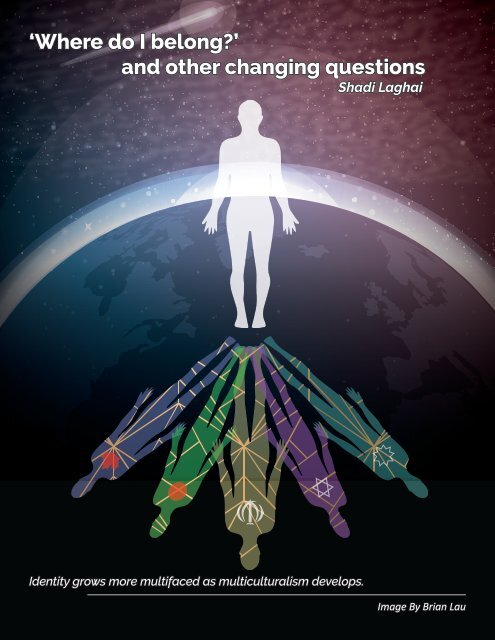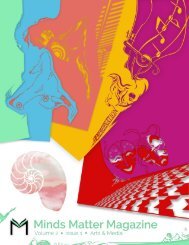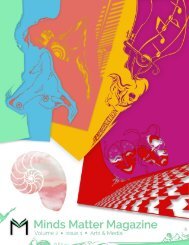Culture & Identity
You also want an ePaper? Increase the reach of your titles
YUMPU automatically turns print PDFs into web optimized ePapers that Google loves.
‘Where do I belong?’<br />
and other changing questions<br />
Shadi Laghai<br />
<strong>Identity</strong> grows more multifaced as multiculturalism develops.<br />
Image By Brian Lau<br />
Minds Matter Magazine Volume III Issue I <strong>Culture</strong> & <strong>Identity</strong><br />
When making sense of one’s identity, questions<br />
include, “Who are you?” “Where do<br />
you belong?,” and the related question, “How<br />
do you treat others?” Is it possible to answer<br />
these questions in ways that satisfy our human<br />
need to belong, without the cost of dividing<br />
humanity into problematic<br />
categories?<br />
<strong>Identity</strong> questions, and the identity crisis<br />
that comes with it, are new.<br />
Yoel Inbar, a social psychology professor<br />
at the University of Toronto (U of T), says<br />
that until recent years, people inherited their<br />
parents’ occupations and lived in more ethnically<br />
homogenous communities. He says people<br />
did not question who they were and what<br />
they were supposed to do, because their<br />
futures were predetermined.<br />
Now, as the global community diversifies,<br />
Inbar says “there’s a universe of choices<br />
that you might feel obliged to optimize that in<br />
the past you didn’t even have to worry about.”<br />
But the freedom of forming our own<br />
identity, suggests Inbar, can have a cost on<br />
our mental health. Anxiety and depression increase<br />
without a strong sense of who you are<br />
and what you should do.<br />
Children of immigrant and multicultural<br />
families can feel the effects of inconsistent<br />
identity most strongly.<br />
Kimia Sedig, a student at Western University,<br />
only started having identity crises in<br />
her teens. She says this is because she did not<br />
understand the complexity of the world as a<br />
child.<br />
“I was like, ‘I am Kimia, and that’s all<br />
there is to it,’” she says.<br />
It did not occur to her that her parents’<br />
Jewish and Iranian culture would have a significant<br />
impact on her identity.<br />
As adults, simple personality identities<br />
do not cut it anymore. When Shakib Mohsin,<br />
a student at U of T, is asked where he is from,<br />
he feels answering “Canada” is insufficient.<br />
To those asking, he is different, and they are<br />
looking for classification.<br />
“It felt like you had to be a part of something<br />
that you didn’t really identify with,”<br />
Mohsin says.<br />
Though Mohsin’s parents are from Bangladesh,<br />
his relatives would mock him for not<br />
speaking Bengali. He also did not identify with<br />
Bengali norms, like loving the taste of fish.<br />
Sedig describes a similar dilemma. She<br />
says it felt like she was “hanging in a limbo<br />
between two nicely boxed cultures” because<br />
she did not have a strong sense of belonging<br />
to either one.<br />
Sedig experienced subtle discrimination<br />
for not being a typical Canadian. At the<br />
same time, because she was not fluent in Farsi<br />
and did not know enough of her cultural<br />
history and its traditions, she felt she was not<br />
“enough” to wholly identify with her parents’<br />
Jewish and Iranian cultures.<br />
Not only did Mohsin and Sedig feel torn<br />
between their cultures, Mohsin says he likes<br />
learning and feeling a connection with many<br />
things, including cultures that he did not<br />
9






